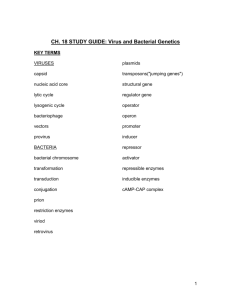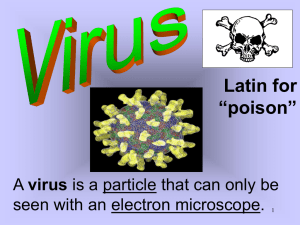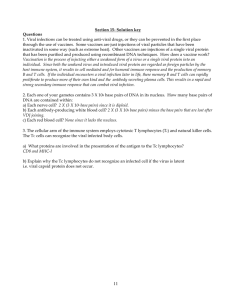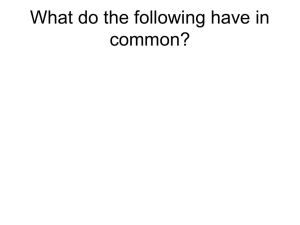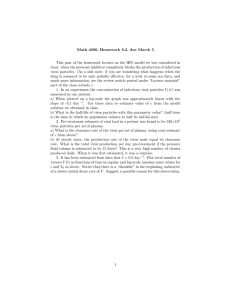Prokaryotes and Viruses 1
advertisement
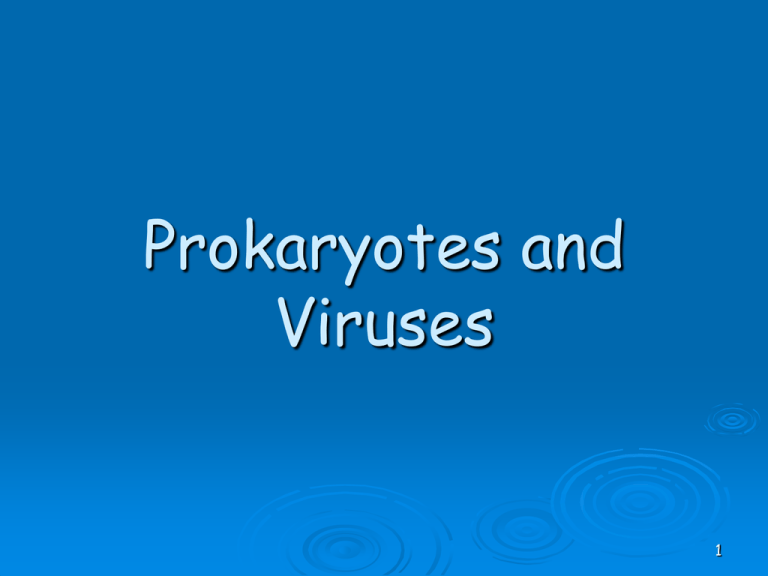
Prokaryotes and Viruses 1 West Nile Virus 2 West Nile Virus One of several mosquito-borne viruses in the United States that can infect people The virus exists in nature primarily through a transmission cycle involving mosquitoes and birds. Mosquitoes become infected with West Nile virus (WNV) when they feed on infected birds 3 West Nile Virus Symptoms Majority of people that become infected with the West Nile virus have no illness or experience only a mild flu-like illness May include fever, headache and body aches lasting only a few days Some persons may also have a mild rash or swollen lymph glands Less than one percent of those infected may develop meningitis or encephalitis, the most severe forms of the disease 4 How Long has the West Nile Virus Been Around? Alexander the Great, 336 B.C., conquered a vast empire It’s speculated that his demise was due to West Nile encephalitis There is still no human vaccine for West Nile virus 5 West Nile Virus Takes Off West Nile Virus is pathogenic, it invades its host and multiplies, causing disease It’s a flavivirus, traveling inside mosquitoes which act as the transferring agent from host to host 6 West Nile Virus Takes Off 7 West Nile Virus Takes Off 8 Impacts, Issues Video West Nile Virus Takes Off 9 Microorganisms Single-celled organisms that are too small to be seen without a microscope Bacteria are the smallest living organisms Viruses are smaller but are not alive 10 The Prokaryotes Only two groups Archaebacteria and Eubacteria Arose before the eukaryotes 11 Prokaryotic Characteristics No membrane-bound nucleus Single Cell chromosome wall (in most species) Prokaryotic Metabolic fission diversity 12 Prokaryotic Body Plan DN A capsule bacterial flagellum pilus plasma membrane cell wall ribosomes in cytoplasm cytoplasm 13 Prokaryotic Body Plan cytoplasm, with ribosomes DNA, in nucleoid pilus bacterial flagellum outer capsule cell wall plasma membrane 14 Prokaryotic Body Plan Prokaryotic body plan 15 Bacterial Shapes coccus bacillus spirillum 16 Bacterial Shapes 17 Bacterial Shapes 18 Bacterial Shapes 19 Bacterial Shapes sex pilus 20 Metabolic Diversity Photoautotrophs Chemoautotrophs Chemoheterotrophs 21 Gram Stain 22 Gram Stain Gram stain 23 Bacterial Genes Bacteria have a single chromosome Circular molecule of DNA Many bacteria also have plasmids Self-replicating circle of DNA that has a few genes Can be passed from one cell to another 24 Prokaryotic Fission 25 Prokaryotic Fission 27 Prokaryotic Fission 28 Prokaryotic Fission 29 Prokaryotic Fission 30 Prokaryotic Fission 31 Prokaryotic Fission 32 Prokaryotic Fission 33 bacterial chromosome Bacterium before DNA replication DNA replication begins parent DNA molecule DNA replication completed DNA copy 34 Membrane growth moves DNA molecules apart New membrane and cell-wall material deposited Cytoplasm divided in two 35 Prokaryotic Fission - 3 Prokaryotic fission 36 Conjugation Transfer of plasmid 37 nicked plasmid conjugation tube Conjugation Prokaryotic conjugation 39 Prokaryotic Classification EUBACTERIA (Bacteria) ARCHAEBACTERIA (Archaea) EUKARYOTES (Eukarya) •Traditionally classified by numerical taxonomy •Now increased use of comparative biochemistry 40 Prokaryotic Classification to ancestors of eukaryotic cells DOMAIN BACTERIA DOMAIN BACTERIA biochemical and molecular origin of life 41 Eubacteria Includes most familiar bacteria Have fatty acids in plasma membrane Most have cell wall; always includes peptidoglycan Classification based largely on metabolism 42 Eubacterial Diversity Photoautotrophic Aerobic (Cyanobacteria) Anaerobic (Green bacteria) Chemoautotrophic Important in nitrogen cycle Chemoheterotrophic Largest group 43 Eubacteria Examples of eubacteria 44 Eubacterial Diversity 45 Eubacterial Diversity 46 Eubacterial Diversity 47 Some Pathogenic Eubacteria Most are chemoheterotrophs E. coli strains Clostridium botulinum Clostridium tetanus Borrelia burgdorferi Rickettsia rickettsii 48 resting spore Some Pathogenic Eubacteria photosynthetic cell heterocyst 49 Some Pathogenic Eubacteria 50 Some Pathogenic Eubacteria 51 Some Pathogenic Eubacteria DNA spore coat capsule around cell wall 52 Bacterial Behavior Bacteria move toward nutrient-rich regions Aerobes move toward oxygen; anaerobes avoid it Photosynthetic types move toward light Magnetotactic bacteria swim downward Myobacteria show collective behavior 53 Bacterial Behavior 54 Archaebacteria 55 Archaebacteria Methanogens Extreme halophiles Extreme thermophiles 56 Methanogens 57 Methanogens 58 Extreme Halophiles 59 Extreme Thermophiles 60 Extreme Thermophiles 61 Virus Noncellular Protein core infectious agent wrapped around a nucleic acid Cannot reproduce itself; can only be reproduced using a host cell 62 Viral Body Plans Complex virus (bacteriophage) Genetic material is DNA or RNA Coat is protein Helical virus Polyhedral virus 63 Enveloped Virus (HIV) viral protein lipid envelope (derived from host) viral RNA viral coat (proteins) reverse transcriptase 64 viral RNA Enveloped Virus (HIV) protein subunits of coat 18 nm diameter , 250 nm length 65 Enveloped Virus (HIV) 80 nm diameter 66 Enveloped Virus (HIV) 65–nm diameter head, 225 nm total length DNA protein coat sheath base plate tail fiber 67 viral coat (proteins) Enveloped Virus (HIV) reverse transcriptase 100-120 nm diameter viral RNA lipid envelope: proteins span the envelope, line its inner surface, spike out above it 68 Viral Body Plans Body plans of viruses 69 70 71 Viruses 72 Viruses 73 Viruses 74 Viruses 75 Viral Multiplication - Basic Steps Attach to host cell Enter host (virus or just genetic material) Direct host to make viral genetic material and protein Assemble Release viral nucleic acids and proteins new viral particles 76 Viral Replication Bacteriophage multiplication cycles 77 Lytic Pathway e Lysis of host cell is induced; infectious particles escape. d The coats get tail fibers, other parts. Lytic Pathway a Virus particle injects genetic material into a suitable host cell after binding to its wall. c Viral proteins are assembled into coats around viral DNA. b Viral DNA directs host cell to make viral proteins and replicate viral DNA. a-1 Viral DNA is integrated into the host’s chromosome. a-2 Before prokaryotic fission, the bacterial chromosome with the integrated viral DNA is replicated. a-4 Viral DNA is excised from the chromosome. Lysogenic Pathway a-3 After cell division, each daughter cell will have recombinant DNA. 78 Fig. 21-15, p.344 Lytic Pathway 79 Lytic Pathway Lysis of host cell is induced; infectious particles escape. Tail fibers and other parts are added to coats. Virus particles bind to wall of suitable host. Viral genetic material enters cell cytoplasm. Viral protein molecules are assembled into coats; DNA is packaged inside. Viral DNA directs host machinery to produce viral proteins and viral DNA. 80 Lytic Pathway Lytic pathway 81 Lysogenic Pathway Viral DNA usually becomes integrated into the bacterial chromosome. Prior to prokaryotic fission, the chromosome and integrated viral DNA are replicated. Viral DNA is excised from chromosome and cell enters lytic pathway. After binary fission, each daughter cell will have recombinant DNA. 82 Lysogenic Pathway Lysogenic pathway 83 Replication of an Enveloped Virus DNA virus particle plasma membrane of host cell Replication of viral DNA Transcription of viral DNA viral DNA Translation some proteins for viral coat nuclear envelope other proteins for viral envelope 84 Replication of an Enveloped Virus 85 Replication of an Enveloped Virus Enveloped DNA virus replication 86 Nature of Disease Contagious disease pathogens must directly contact a new host Epidemic Pandemic (AIDS) Sporadic Endemic 87 Evolution and Disease Host and pathogen are coevolving If a pathogen kills too quickly, it might disappear along with the individual host Most dangerous if pathogen Is overwhelming in numbers Is in a novel host Is a mutant strain 88 Mycobacterium tuberculosis 89 SARS virus 90 91 New Threats Emerging Pathogens Ebola virus Monkeypox virus SARS virus Drug-resistant Food strains poisoning E. coli Salmonella 92 Viroids Smaller than viruses Strands or circles of RNA No protein-coding genes No protein coat Cause many plant diseases 93 Prions Small proteins Linked to human diseases Kuru Creutzfeldt-Jakob disease (CJD) Animal diseases Scrapie in sheep Bovine spongiform encephalopathy (mad cow disease) 94 95 96 97 98 99 100


